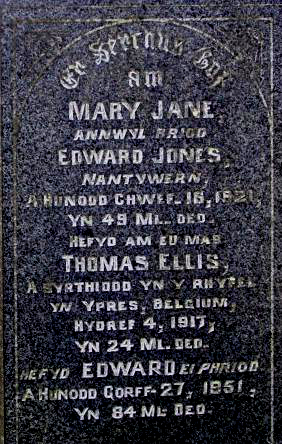Gunner Thomas Ellis Jones
Killed in action 4th October 1917
 Thomas was born in 1893 to farmer, Edward Jones and his wife, Mary. In the 1901 census, the eight year Thomas is recorded as living with his parents and five siblings at Nant-y-Wern, Penybont Fawr, which just so happened to be the next property to Glanafon Uchaf where the eight year old Griffith Evans was living. It seems more than likely that they knew each other well, probably going to school together. By 1911, ten years on, Thomas was living as a farm servant with a farmer, Thomas Davies Jones, at Ty’n Cablyd, Llangynog.
Thomas was born in 1893 to farmer, Edward Jones and his wife, Mary. In the 1901 census, the eight year Thomas is recorded as living with his parents and five siblings at Nant-y-Wern, Penybont Fawr, which just so happened to be the next property to Glanafon Uchaf where the eight year old Griffith Evans was living. It seems more than likely that they knew each other well, probably going to school together. By 1911, ten years on, Thomas was living as a farm servant with a farmer, Thomas Davies Jones, at Ty’n Cablyd, Llangynog.
After war broke out he enlisted in Dolgellau into 76th Brigade, Royal Field Artillery as a gunner. A typical gun crew comprised ten men, a sergeant in charge, a bombardier, and five gunners, with three in reserve to bring up the ammunition. When on the move, the eighteen pounder gun was hooked up to a two wheeled limber pulled by six horses in pairs, a driver on the left hand horse of each pair. The Brigade fought at the Battle of Loos, in 1915, before a Somme campaign the following year. In April 1917 they supported troops of the 4th Canadian Division at the Battle of Vimy Ridge, part of the British-led battle of Arras. Later, July-November the brigade fought in the battle of Passchendaele. It is very likely that Gunner Thomas Ellis Jones was killed here. He lost his life on the 4th October 1917, aged 24. He is buried and commemorated at Cement House Cemetery, Langemarch, Belgium. He is also commemorated on the Llanrhaeadr war memorial, and in Pennant Melangell churchyard, on the headstone of his parents grave. His mother died just four years later, but his father lived on until 1951. |